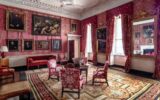
The photograph taken by Henry Shaw (Fig. 1) c. 1880 shows the Crimson Drawing Room not long after its completion in all its splendour and gives a glimpse of the heady mixture of periods and tastes it combined: in the corner is one of a pair of Lady Louisa’s French cabinets by Lacroix (bought for her in Paris by her sister Lady Caroline Fox in 1763), an array of exotic Bombay gilt furniture with its lace-like carvings is arranged around the centre of the room, and a collection of predominantly large religious paintings by famous Old Masters such as Vasari, Murillo or Mazzolini hangs against the backdrop of the patterned silk. This opulent scheme was devised by Thomas Conolly (1823–1876), whose habits were every bit as sociable and spendthrift as those of his ancestor of the same name. He sought adventure abroad and became acquainted with such illustrious figures as Napoleon III in Paris as well as General Lee in Virginia. During the American Civil War, he attempted to restore his family’s fortune through blockade running (he failed) and kept a diary on the fall of the Confederacy. After Thomas returned from his travels, he married Sarah Eliza Shaw, the daughter of Joseph Shaw, owner of the Celbridge Paper Mills, which were one of the largest industrial complexes in Ireland at the time. Together they travelled to Italy in 1870/71, and although no account books of the period survive, it is most likely that Thomas embarked on the refurbishment of the Crimson Drawing Room shortly afterwards with funds supplied by his wife’s dowry of £10,000 (worth over £1,000,000 today). It may even be that the silk itself was ordered from Italy, as recent research has shown that the unusual artichoke and leaf pattern in Castletown can be found in the Sala delle Udienze in the Royal Palace in Genoa and, in green silk, in the Salone Verde in Palazzo Pitti, Florence. In the absence of account records for that period the exact provenance remains a mystery, but what can be said with certainty is that the damask was of the highest quality, its lustre and two tonal design the product of unsurpassable hand weaving on Jacquard looms.
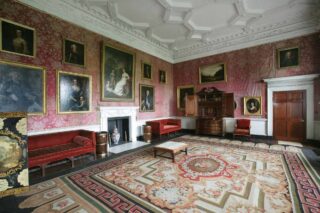
However, over the course of more than a century both the Crimson Drawing Room and the fabric changed appearance. Most of the paintings and furniture were irretrievably lost at auction sales, the curtains and light fittings disappeared, and the vibrant fabric itself suffered from exposure to light, heat, and careless handling. By the time Castletown came into State ownership in 1994, the house’s interior and exterior needed extensive repairs, but once those were completed in 1999, ‘the conservation of the embrittled mid-nineteenth-century silk damask wall hanging in the Red Drawing Room’ was identified as a next priority in Building for Government: The Architecture of State Buildings. Several reports were commissioned from different textile conservators, but it was only when the silk was understood within the context of the multiple historic layers that define the Red Drawing Room today – and the Red Drawing Room’s place within the ensemble of rooms that constitute the north enfilade in the house – that the project could be embarked on with confidence. Launched in 2015 and completed in 2018, this conservation project included three partners – the OPW, the Castletown Foundation and the Apollo Foundation – and involved three different aspects of conservation and restoration, all of which aimed to restore the historic character of the room: the conservation of the original nineteenth-century silk wall hangings, the replication of the original silk for curtains and drapes similar to the ones that were once in the room, and the curation of a Grand Tour picture hang and furniture arrangement in the spirit of historic records as far as possible. On the West Wall and East Wall the silk panels were carefully cleaned and secured by two textile specialists, May Berkouwer and Ksynia Marko, who developed methods to successfully tackle even the most difficult areas in situ. The result is a harmonious, intact appearance of the treated walls where faded areas have been revived, areas of loss have been successfully infilled with silk dyed in a matching colour and tears have been closed in such a way that they are no longer visible.
The experience gathered on the first two walls stood the conservators in good stead as they prepared for their biggest trial: scaling the worst damaged South Wall. Even within the genteel surroundings of the Red Drawing Room, conserving this brittle wall was nothing short of pioneering work, though the tools of the trade may be delicate tweezers, silk crepeline or adhesive net (Figs 3 & 4).
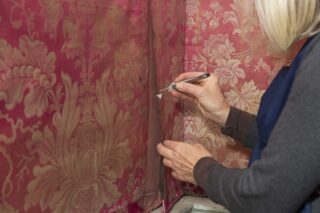
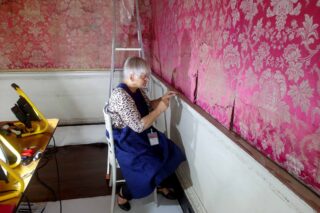
In parallel with these conservation works, Humphries Weaving in the United Kingdom was commissioned to faithfully copy the intricate design and weave of the wall hangings and to develop a red and white silk thread that matches the colour of the vibrancy of the original silk. Although their looms are not the same as those that were used in the nineteenth century, the silk reproduction they produced is remarkably like the original. The new fabric was used for three pairs of curtains to dress the windows and to reupholster some of Lady Louisa’s Chinese Chippendale chairs, which are still in Castletown and which we know were covered in the same fabric as the walls when the Crimson Drawing Room was refurbished in the 1870s. With the walls fully conserved, it was time to install picture rails and an exciting new picture hang of Old Masters on loan from the Schorr Collection which includes, for example, paintings by Rubens and Giordano. A photograph can only show so much (Fig. 5), so why not put Castletown House on your itinerary in 2020 and discover, or rediscover, a whole new facet of this Italian palace on the banks of the Liffey?
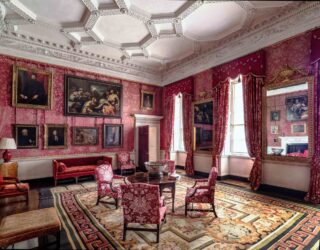
To find out more about the conservation project watch this YouTube video of the two conservators at work on the East Wall:
About the Author
Dr Dorothea Depner worked as a Visiting Research Fellow in Trinity College before joining the OPW in 2015. She was responsible for developing the visitor experience at Castletown House and managed the Red Drawing Room conservation project. She currently works in OPW’s Art Management section.
